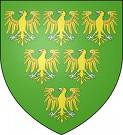Caerphilly castle currently has an exhibition running on the building of the castle and two historical people linked to the castle. One is Llywelyn Bren, the other Edward II.
After the death of Gilbert de Clare at the battle of Bannockburn in 1314, his lands were divided between his 3 sisters. Hugh Despencer the younger, was married to Eleanor de Clare, the eldest sister and niece of Edward II. He was also the ‘favourite’ of Edward II. He chose the largest portion of the de Clare lands, the lordship of Glamorgan, which included the castles of Caerphilly and Cardiff. The current custodians of Caerphilly castle, CADW, are in no doubt of his greed, ambition and treachery. Llywelyn Bren had led a revolt in 1316 and attacked Caerphilly castle. The revolt spread throughout Glamorgan. A royal army was assembled and sent to quell the revolt. Llywelyn surrendered, and asked for royal mercy. He was sent to the Tower of London. However, in 1318, in an act of ‘wanton cruelty’, Despencer had him brought to Cardiff, where he was hanged, beheaded and quartered. Llywelyn’s story is told with sympathy and compassion. Despencer is definitely the ‘bully boy’. Llyeleyn’s body was buried in Greyfriars church in Cardiff, which no longer exists – yes, another victim of the Reformation. A tower block currently stands on the site.
The second history story centres on Edward II, and obviously involves Despencer again. When the castle’s restoration was begun, a carved head was found, and identified as that of Edward II. Despencer spent a lot of time and money on Caerphilly, and the great hall’s supporting pillars had the heads of the Despencer family and the king carved into them. The head is no longer at the castle – probably kept in Cardiff museum. Edward fled with Despencer, and his treasure, to Caerphilly castle when his estranged Queen, Isabella, and her favourite, Mortimer, staged an invasion to seize the crown for Prince Edward. They stayed a few nights at Caerphilly, from October 29th until November 2nd, before fleeing to the Cistercian abbey at Neath. Edward took some of the treasure with him and hurriedly hid it, so the story goes, throughout the abbey. Edward and Despencer then fled the abbey and were then captured near Llantrisant.
The inventory taken in 1327 at Caerphilly makes fascinating reading. Amongst the arms found there were 1,130 crossbows fitted with hedgehog quills! £13,000 was found packed into 26 barrels, and a further £1,000 was found in a barrel belonging to Despencer. The king’s personal belongings included his armour, his bed, a mattress, canopy and curtains, two sheets, four pillows, a silk coverlet, a red dressing-gown, doeskin gauntlets and a black cap decorated with butterflies and pearls. Edward’s story concludes with him being dismissed as weak and foolish, and being murdered ‘horribly’ at Berkley castle. At one pint in the commentary, his wife changes from Isabella to Eleanor!
Stories of Edward II’s treasure hidden around Neath are part of local legend. Coins have been found hidden around the Abbey, dating from Edward II. Being somewhat of a local myself, I’ve grown up with stories of ‘the English king’s treasure’ being hidden around Neath. Parts of the Abbey remain in various decayed states, and the town has grown up around it. One interesting fact is the story of Edward and Isabella’s ‘wedding certificate’ turning up in the 19th century. A doctor was called out to treat a farmer’s wife, and the farmer, unable to pay the doctor, gave him the certificate which had been in his family ‘for years’. He couldn’t read it, had no idea what it was, but felt it may be worth something!
1 week ago



3 comments:
I'd love to see that carved head of Edward's! The 1327 inventory is brilliant - I love the cap with butterflies and the retiring-robe decorated with bears especially. ;) Weird though that they got Isabella's name wrong, and calling Ed ' weak' - hmmmmm. That's debatable!
Alianore, re Edward being 'weak', - it's just 'touristy' commentary really. They have a board there with pictures that lights up when the commentary focuses on that part of the story. Llewelyn Bren's worked fine - poor Ed failed to light up in his story! Really annoying the guide didn't say where the head was - but it's bound to be in Cardiff museum - I'll try and find out.
Re the cap - wonder why they felt the need to go into such detail?
I suppose you can't really blame CADW for taking the side of Bren - and Hugh did gain his reputation (albeit a bit later) rather deservedly.
I think we should all go on a search for that buried treasure though ;-)
Post a Comment